What is a terrine, exactly? Julia Child referred to it as "a luxurious cold meatloaf". It's not a bad description really, at least for our American minds. I tell people that it's a really fancy sausage, which is also kind of true, but it doesn't really tell the whole story.
First, it helps to know what a forcemeat (aka "farcemeat") is. If you take a bunch of lean meat and fat, and then process it together until it forms an emulsion (meaning you get two things to stick together that don't normally want to stick together), you will have a forcemeat. Technically, sausage is a type of forcemeat.
There are varying degrees of texture in a forcemeat, from coarse to smooth and silky. A salami or andouille are a little coarser, while a pate is very fine. Now if you take this forcemeat, put it in an earthenware mold (called a terrine), cover it with a tight lid and then bake it and cool it before serving, you would have a pate en terrine, or just terrine.
Truth is, the earthenware mold may be traditional, but it's not strictly necessary. I actually own a couple of different terrine molds, one triangle-shaped and one U-shaped. The thing is, if you had a terrine mold laying around, you and I wouldn't be having this discussion; you would be skipping straight to the recipe. Don't worry, for you normal people out there, you can use a regular old bread loaf pan.
A traditional terrine will be meat-based, but there are of course non-traditional variations out there. One of the prettiest and most delicious-looking terrines I ever saw was almost entirely comprised of vegetables, with a layer of goat cheese, and a bit of aspic holding it together. Vegetarians are welcome to use agar instead of aspic. Vegans can leave out the goat cheese. I have also attempted a few dessert terrines in the past, all of which were tasty, but none of which were pretty.
The terrine I show you today will be more or less traditional. I decided to augment the chicken with a little pork fat, to boost the flavor and maintain moisture. I think that a strictly traditional terrine would only have chicken or pork + pork fat, but not both. But hey, it's my terrine, and I'm gonna do it my way. I also love mixing sweet and savory, so I added a couple of different types of dried fruit.
Dried fruit is a pretty classic internal garnish, but I thought I would spike the flavor by soaking it in juice first. Since I was using dried cherries, I went with cherry juice (okay, technically carbonated cherry juice). Traditionally you would probably use wine, sherry, port, some fruit Liqeur, etc., but I thought cherry juice would go well with this.
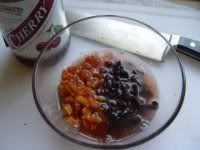
While the fruit was soaking, I diced up a couple of pounds of chicken thighs and a half pound of salt pork. You can use fat back if you can find it (I couldn't), but keep in mind the significant difference in saltiness. Both the chicken and pork were pretty cold having just been thawed (there was even a little ice still), and that's good. You won't see this in the recipe at the bottom, but you want to keep the meat ice cold as it goes through the grinder. There's a lot of friction happening in there, and you actually run the risk of prematurely cooking some of the meat. If you think the grinder is running too hot, feel free to pour a little ice water in with the meat.
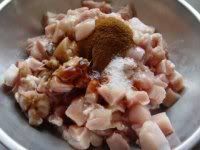
Tossing the spices and other flavorings with the meat before grinding will help integrate the flavor into everything. Since the dried fruit is a garnish, you want to wait until after grinding the meat before folding it in. See how much juice the dried fruit soaked up? Pour in the remaining juice too, it'll help with flavor.
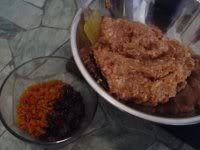
This is a good time to check for seasoning. Even I would never recommend tasting the seasoning on raw meat, and it really wouldn't give you a good idea of the cooked flavor anyway. It's much better to take just a little of the mixture and cook it in a saute pan before tasting it. Try not to brown it, since the final product will also not be browned, and you don't want to throw off the flavor.
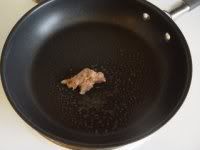
When you've decided you like the flavor, go ahead and move it into a prepared terrine mold. I prepare mine by spraying with cooking spray, lining it with foil, and then spraying it again. But that's just me. Scoop it all in, making sure to get everything in the corners. When you have it all in, go ahead and smooth it on top with a rubber spatula. If you have extra... well, just saute it now. It'll be a nice little Scooby snack. Fold the foil over the top to completely cover the meat.

The biggest problem with my commercial terrine molds is that they don't fit well onto oven racks. They don't fit on cookie sheets or half-size sheet pans either. They do fit onto full-size sheet pans, but those don't fit into residential ovens. Just do your best, but definitely make sure you have a sheet of foil on the rack underneath; stainless steel molds like mine aren't necessarily waterproof, and some of the juice will leak.
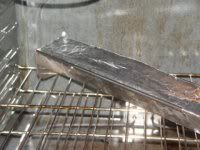
Bake at 300F for about an hour, until the center reaches 165F. A probe thermometer is best for this, of course. You can go ahead and pull it a few degrees early and let it rest on the counter for a bit before moving to the fridge. Yes, you can eat it hot. But that's not very traditional, so go ahead and chill it for a few hours.
When you're ready to serve, go ahead and slice it into about 1/4-inch slices. A good terrine is good all by itself, but I wouldn't rule out serving smaller pieces with crackers. You know, if you're into that sort of thing.

Chicken and Fruit Terrine
1/3 cup dried apricots, diced
1/3 cup dried cherries, diced
1/2 cup cherry juice
2 pounds dark-meat chicken
8 oz salt pork, rind removed
1 tsp Kosher salt
2 tsp chile powder
2 tsp chipotle Tabasco
1 Tbsp Worcestershire sauce
* Preheat oven to 300F.
* Soak the diced fruit in the cherry juice. Set aside for at least one hour.
* Cut the chicken and pork into 1/2-inch cubes.
* Toss the meat and the rest of the ingredients together.
* Process the meat mixture in a meat grinder.
* Fold in dried fruit and fruit juice.
* Move everything into a prepared terrine (or loaf) pan, and smooth the top with a spatula.
* Bake at 300F for 60 to 70 minutes, or until the terrine reaches an internal tempurature of 165F.
* Remove from oven and allow to rest for a few minutes before moving to the refrigerator to chill.
* Cut into slices and serve cold.
Joseph, I read your blog fairly regularly, but never comment -- your recipes usually send me to the kitchen looking for something to eat -- but I thought I'd let you know this terrine sounds like a great thing to make. I've always wanted to make some homemade sausage, but never got around to it, this looks like something even your uncle Mike could do. And the Perl hints are fun too. I have used vi for several years and until I read your post today, I didn't even know it was just short for vim. But since most of my UNIX/Linux tasks are one off things I don't get into making sure my environment is set up in a particular way.
ReplyDeleteThe fruit terrine is an easy-to-prepare dish to do at home.
ReplyDelete